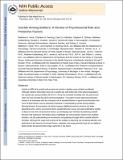| dc.contributor.author | Nock, Matthew K. | |
| dc.contributor.author | Deming, Charlene Ann | |
| dc.contributor.author | Fullerton, Carol S. | |
| dc.contributor.author | Gilman, Stephen Edward | |
| dc.contributor.author | Goldenberg, Matthew | |
| dc.contributor.author | Kessler, Ronald | |
| dc.contributor.author | McCarroll, James E. | |
| dc.contributor.author | McLaughlin, Katie Anne | |
| dc.contributor.author | Peterson, Christopher | |
| dc.contributor.author | Schoenbaum, Michael | |
| dc.contributor.author | Stanley, Barbara | |
| dc.contributor.author | Ursano, Robert J. | |
| dc.date.accessioned | 2017-07-14T21:10:02Z | |
| dc.date.issued | 2013 | |
| dc.identifier | Quick submit: 2017-05-30T16:25:22-0400 | |
| dc.identifier.citation | Nock, Matthew K., Charlene A. Deming, Carol S. Fullerton, Stephen E. Gilman, Matthew Goldenberg, Ronald C. Kessler, James E. McCarroll, et al. 2013. “Suicide Among Soldiers: A Review of Psychosocial Risk and Protective Factors.” Psychiatry: Interpersonal and Biological Processes 76 (2) (June): 97–125. doi:10.1521/psyc.2013.76.2.97. | en_US |
| dc.identifier.issn | 0033-2747 | en_US |
| dc.identifier.uri | http://nrs.harvard.edu/urn-3:HUL.InstRepos:33459447 | |
| dc.description.abstract | Suicide is difficult to predict and prevent and remains a leading cause of death worldwide. Although soldiers historically have had a suicide rate well below that of the general population, the suicide rate among members of the U.S. Army has increased markedly over the past several years and now exceeds that of the general population. This paper reviews psychosocial factors known to be associated with the increased risk of suicidal behavior in general and describes how some of these factors may be especially important in understanding suicide among soldiers. Moving forward, the prevention of suicide requires additional research aimed at: (a) better describing when, where, and among whom suicidal behavior occurs, (b) using exploratory studies to discover new risk and protective factors, (c) developing new methods of predicting suicidal behavior that synthesize information about modifiable risk and protective factors from multiple domains, and (d) understanding the mechanisms and pathways through which suicidal behavior develops. Although the scope and severity of this problem is daunting, the increasing attention and dedication to this issue by the Armed Forces, scientists, and society provide hope for our ability to better predict and prevent these tragic outcomes in the future. | en_US |
| dc.description.sponsorship | Psychology | en_US |
| dc.language.iso | en_US | en_US |
| dc.publisher | Guilford Publications | en_US |
| dc.relation.isversionof | doi:10.1521/psyc.2013.76.2.97 | en_US |
| dc.relation.hasversion | https://www.ncbi.nlm.nih.gov/pmc/articles/PMC4060831/ | en_US |
| dash.license | OAP | |
| dc.title | Suicide Among Soldiers: A Review of Psychosocial Risk and Protective Factors | en_US |
| dc.type | Journal Article | en_US |
| dc.date.updated | 2017-05-30T20:24:06Z | |
| dc.description.version | Accepted Manuscript | en_US |
| dc.relation.journal | Psychiatry: Interpersonal and Biological Processes | en_US |
| dash.depositing.author | Nock, Matthew K. | |
| dc.date.available | 2013 | |
| dc.date.available | 2017-07-14T21:10:02Z | |
| dc.identifier.doi | 10.1521/psyc.2013.76.2.97 | * |
| dash.authorsordered | false | |
| dash.contributor.affiliated | McLaughlin, Katie | |
| dash.contributor.affiliated | Deming, Charlene | |
| dash.contributor.affiliated | Gilman, Stephen Edward | |
| dash.contributor.affiliated | Kessler, Ronald | |
| dash.contributor.affiliated | Nock, Matthew | |


